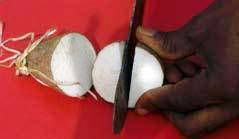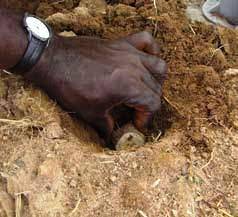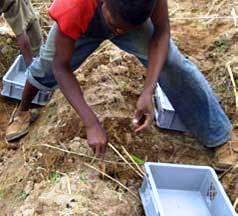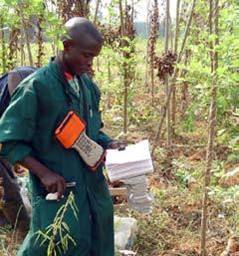Regeneration guidelines for yam
|
View regeneration guidelines in full (in PDF)
Also available in the following languages: |
The information on this page was extracted from:
Dumet D. and Ogunsola D. 2008. Regeneration guidelines: Yams.
In: Dulloo M.E., Thormann I., Jorge M.A. and Hanson J., editors. Crop specific regeneration guidelines [CD-ROM]. CGIAR System-wide Genetic Resource Programme, Rome, Italy. 7 pp.
Before reading the regeneration details for this crop, read the general introduction that gives general guidelines to follow by clicking here.
Introduction
Yams (Dioscorea spp.) are annual or perennial vines and climbers with annual or perennial underground tubers. They belong to the Dioscoreaceae family. This tuber-producing plant is popular in the humid and subhumid tropics, particularly in Africa, the West Indies and parts of Asia and South and Central America. Knuth (1924) estimated that there are about 600 species in the genus Dioscorea L. The most important edible yams belong to only a few species, such as D. rotundata Poir. (widely known as white Guinean yam), D. alata L. (known as water yam, winged yam or greater yam), D. cayenensis Lam. (yellow yam or yellow Guinea yam; may be composed of a complex set of different species), D. esculenta (Lour.) Burkill (lesser yam, potato yam or Chinese yam), D. dumetorum (Kunth) Pax (bitter yam or trifoliate yam), D. bulbifera L. (aerial potato yam), D. trifida L.f. (cush-cush yam), D. opposita auct. (cinnamon yam) and D. japonica Thunb.
Yams are mainly treated as annual during cultivation.Their life cycle consists of the following stages: propagules (true seed or tuber), emerging seedling or plantlet, mature plant, senescing plant and dormant tubers. Yam is generally a short-day plant. The intensity of flowering among commonly cultivated yam ranges from nil to profuse. Yams are principally
conserved vegetatively in field genebanks; efforts are also underway in some genebanks to conserve them in vitro for safety duplication.
Procedures described in this guideline refer to field collections only for the following species: D. alata, D. rotundata, D. cayenensis, D.
bulbifera, D. esculenta, D. dumetorum, D. praehensilis, D. mangenotiana and D. bulkilliana.
Choice of environment and planting season

Yam plant. (photo: M.E. Dulloo) |
Climatic conditions
- Select an environment similar to the collection site. Yams normally grow at low altitudes with precipitation of about 1000–1400 mm per year and mean annual temperatures ranging from 22 to 30°C.
Planting season
- Do not plant accessions at the beginning of the rainy season; wait until the rains are well established and steady. In the West African yam belt, for example, planting is done between mid-March and the end of May.
Preparation for regeneration
When to regenerate
- Regenerate all accessions once a year, starting when tubers break dormancy. In all yam producing zones, tuber dormancy breaks not long before the beginning of the rainy season. In IITA, Ibadan (Nigeria) for example, it is April to June for tubers conserved in a dry cool tuber store at 18–20°C.
Pre-treatments
-
Before planting, treat seed tubers (mini-sets or small tubers) with a mixed solution of insecticide, fungicide and nematicide prepared as follows:
- Perfekthion (insecticide): 40 ml
- Dithane M 45 (fungicide): 50 g
- Basamid fumigant (nematicide): 10 g
- Wood ash: 200 g
- Water: 10 L
- Dip seed tubers into this solution for 2 to 3 minutes, and then leave them in a shaded place (e.g. under a tree) for 18 to 24 hours to allow the cut surface to dry.
Field selection and preparation
- Yams require a loose, deep, free-draining fertile soil with a pH close to neutral.
- Choose a field with no (or very low) pest and disease incidence (viruses, insects, nematodes, fungi).
- The field must be flat land with irrigation facilities and no (or limited) erosion.
- Clear the field of stumps, before mowing, ploughing, harrowing and ridging.
Method of regeneration
Propagation method
- Prepare 30 seed tubers (mini-sets or small tubers) per accession (see photos below). Transfer them to net bags, each labelled with a paper tag.
 |
 |
 |
|
Preparation of minisets. (photos: Dominique Dumet /IITA) |
||
- Tuber seeds (50–250g) can either be full small healthy tubers or larger tubers cut into mini-sets and pre-treated as described above.
- For a high germination rate, size the mini-sets, taking into account the germination ability of the accession as observed (on station) or documented during germplasm surveys.
- Generally, full small healthy tubers are recommended.
Planting method (see photos below)
- Direct plant with a hoe on top of the ridge or mound.
- Place tubers 10–15 cm deep into the soil.
 |
 |
|
Yam planting. (photos: Dominique Dumet /IITA) |
|
Planting layout, density and distance
- Plant 30 mini-sets for each accession.
- Label and divide the field to clearly separate each accession (with tape, rope, bamboo pegs of about 1 m length or other appropriate material).
- For regeneration: allocate a 2.5 m row length for each accession with a 0.5 m pathway.
- For characterization/evaluation: allocate 6 m for each accession with a 1 m pathway.
Labeling
- Use weather-resistant labels.
- When using plastic labels to identify accessions in the field, write details (accession number, code) with pencil, not markers (whether permanent or not), which usually rub off before the end of the season.
Crop management

Stakes for crop management. |
Staking
- When possible, provide a long, strong and well branched stick for each plant or set of plants belonging to the same accession (see photo).
- Place sticks at the beginning of the germination and 50 cm away from the plant.
- Almost any convenient timber or bamboo may be used as a stake.
Weed management
- Carry out weeding twice a month for about 5 months.
Irrigation
- Use irrigation in the dry season; sprinkle water twice a week for 6 hours and for about 2 months.
Fertilization
- Before planting, apply 5 bags (50 kg/bag) of urea per hectare.
- During active growth, if there are signs of deficiency (leaves yellowing or non active growth) apply 3 bags of urea/hectare (only apply when rain is steady), i.e. 5 g per plant.
- Apply fertilizers in a circular or ring form 10 cm away from plant.
Common pests and diseases
- Contact plant health experts to identify the symptoms of the likely pests and diseases and the appropriate control measures.
- During growth, attack by the yam beetle (Heteroligus meles), yam nematodes (mainly Scutellonema bradys and Meloidogyne spp.) and viruses (mostly YMV) may be common.
- The major post-harvest disease is tuber rots caused mostly by fungi: soft rots caused by Penicillium spp., Fusarium oxysporum and Botrydiplodia theobromae; dry rots caused by Rosselinia and Sphaerostilbe. Other frequently encountered fungi are Rhizopus nodosus and F. solani.
Pest and disease control
- Only regenerate healthy tubers; eliminate rotten tubers and those with mealy bugs, rodent damage or showing fungus.
Preventive:
- Against insects (mealy bug etc.) use insecticides such as Tricel, Indocel or Perfecktion at 80 ml/20 L of water.
- Against rodents use bait traps with peanut butter (preferably) or rodent poison products.
- Against fungus use fungicide such as Dithane M45 (50 g into 20 L of water)
- Use dry grass as mulch to cover exposed tubers to protect them from rodent attack and sun scorching).
Non-preventive:
- Do not keep plants with obvious virus infection. Label as infected and destroy them.
Harvesting
- Once plants have senesced (all dried), dig out tubers with a 2-m-long iron stick, cutlass and hoe. Gently brush each tuber before transferring it to a net bag. Weigh each bag and send it for post-harvest treatment.
Post-harvest management
- Apply the same treatment as before planting (described above).
- After drying, transfer tubers to yam barns. Place each bag on the shelves (avoid compact storage) for 4 to 6 weeks.
- Transfer bags to yam store (temperature = 18–20°C, i.e. in a dry cool area) for conservation for 3 to 4 months.
- During storage, check yam germplasm weekly (look for rotting, insect and rodent damage etc.).
- Monitor sprouts until follow-on dormancy break.
Documentation of information during regeneration
Collect the following information during regeneration:
- Accession number
- Regeneration site name and map/GPS reference
- Environmental conditions (altitude, precipitation, soil type, others)
- Name of collaborator (only if NARS involved)
- Field layout used: field/plot/nursery/greenhouse reference
- Flower type (male/female)
- Number of tubers sorted
- Number of tubers planted
- Planting date (±more than 7 days)
- Number of plants germinated
- Field management details (watering, fertilizer, weeding, pest and disease control, stresses recorded, others)
- Date of first harvest and method
- Date of final harvest
- Number of tubers harvested
- Total weight (kg)
- Location in yam store
- Date of first sprouting (during storage)
- Agronomic evaluation; agro-morphological traits recorded
- Post-harvest (describe any relevant procedures)
References and further reading
Bioversity International, IITA. 2009. Key access and utilization descriptors for yam genetic resources. Bioversity International, Rome, Italy; International Institute of Tropical Agriculture, Nigeria. Available here.
Knuth R. 1924. Dioscoreaceae. In: Engler A, editor. Das Pflanzenreich 87(IV-43): 1–387.
Orkwor GC, Asiedu R, Ekanayake IJ, editors. 1998. Food Yams. Advances in Research. International Institute of Tropical Agriculture and National Root Crops Research Institute, Nigeria.
Acknowledgement
These guidelines have been peer reviewed by Alexandre Dansi, University of Abomey-Calavi, Benin, and Perla Hamon, Institute de Recherche pour le Développement (IRD), France.






Leave your comments
Post comment as a guest